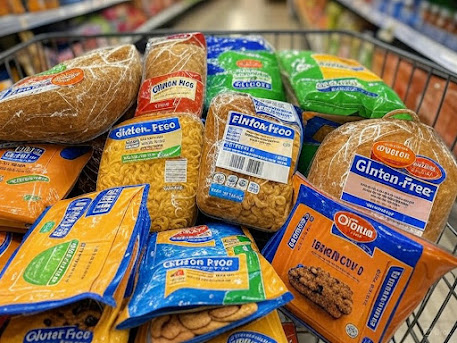In recent years, the gluten-free industry has exploded. Supermarkets are now packed with gluten free processed foods — from cookies and breads to frozen meals and snacks. For people with celiac disease or gluten intolerance, it might feel like a dream come true.
But here’s the thing: just because something is labeled gluten-free doesn’t mean it’s automatically healthy.
✅ What Are Gluten-Free Processed Foods?
Gluten-free processed foods are packaged products made without wheat, barley, or rye — the primary sources of gluten. Examples include:
-
Gluten-free bread, cookies, and crackers
-
Ready-to-eat meals
-
Chips, cereals, and bars
-
Baking mixes
Many people assume these are healthier versions of regular processed foods. But is that really true?
❗ The Hidden Truth: Gluten-Free Doesn’t Mean Guilt-Free
Here’s what most people don’t realize:
Many gluten-free processed products are highly refined and filled with:
-
Added sugars
-
Unhealthy oils
-
Starches like tapioca, potato, or rice flour
-
Low fiber content
These ingredients improve texture but often strip away nutrition, leaving you with empty calories.
⚠️ Potential Downsides of Relying on Gluten-Free Processed Foods
1. Nutrient Deficiencies
Many gluten-free products lack essential vitamins, minerals, and fiber because they’re made from refined flours and starches.
2. Blood Sugar Spikes
Highly processed gluten-free snacks can cause rapid blood sugar spikes, leading to cravings and fatigue — especially common with gluten-free breads and sweets.
3. Hidden Calories
Because of added sugar and fat, gluten-free versions of cookies or cakes can have more calories than their gluten-filled counterparts.
✅ How to Choose Better Gluten-Free Products
1. Read the Ingredients
Look for products made with whole grains like brown rice, quinoa, or buckwheat rather than just starches.
2. Check Fiber and Protein
Healthy gluten-free foods should have fiber and protein to keep you full and satisfied.
3. Watch the Sugar and Fat
Compare nutrition labels. Some gluten-free snacks contain double the sugar of regular options.
🍎 Best Alternatives to Processed Gluten-Free Foods
✅ Whole, Naturally Gluten-Free Foods:
-
Quinoa, rice, buckwheat
-
Lean proteins: chicken, fish, eggs
-
Fresh fruits and vegetables
-
Nuts, seeds, and legumes
✅ Homemade Snacks:
-
DIY gluten-free granola
-
Rice cakes with nut butter
-
Hard-boiled eggs
-
Hummus with veggie sticks
🌟 Final Thoughts
The gluten-free label doesn’t automatically make a food healthier. Many gluten free processed foods are just as unhealthy — or worse — than regular processed foods.
The key is to focus your diet on whole, naturally gluten-free foods and enjoy processed items occasionally, not daily. Your body will thank you with better energy, digestion, and long-term health.


